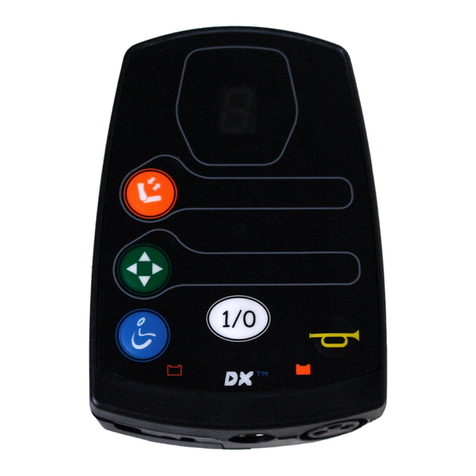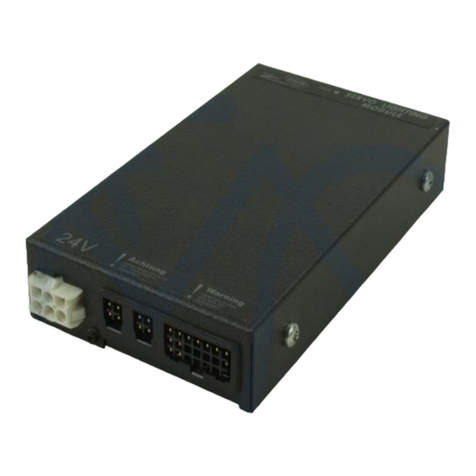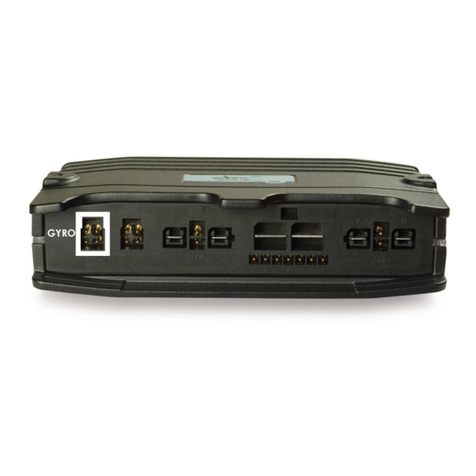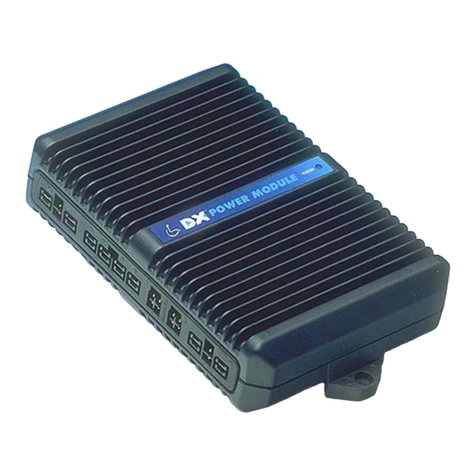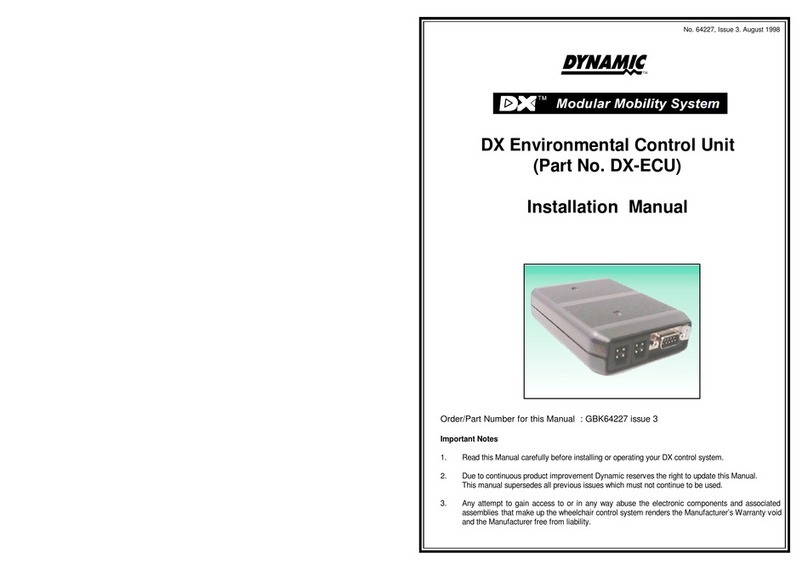Dynamic DX 12V User manual

No. 60011, Issue 8. October 1998
TM
DX 12V Lighting Module
Installation Manual
Order/Part Number for this Manual : GBK60011 issue 8
Important Notes
1. Read this Manual carefully before installing or operating your DX control system.
2. Due to continuous product improvement Dynamic reserves the right to update this Manual.
This Manual supersedes all previous issues which must not continue to be used.
3. Any attempt to gain access to or in any way abuse the electronic components and
associated assemblies that make up the wheelchair control system renders the
Manufacturer’s Warranty void and the Manufacturer free from liability.

No. 60011, Issue 8. October 1998
Contents
1Introduction ...............................................1
2Related Documentation .....................................2
3General Description ........................................3
3.1 General Features ............................................4
3.2 Safety and Protection Features ................................4
4Specifications .............................................5
4.1 Electrical Specification .......................................5
4.2 Mechanical Specifications ....................................6
4.3 Environmental Specifications ..................................7
5Installation ................................................8
5.1 General ...................................................8
5.2 Mounting ..................................................8
5.2.1 Environmental Protection ...............................8
5.2.2 Securing the 12VLM ...................................9
5.3 12VLM Connection with the DX System ......................11
5.3.1 21 Way Connector Pin Definitions ........................11
5.3.2 Wires and Terminations ..................................11
5.3.3 DXBUS Connections ...................................12
5.3.4 12VLM Connection to the Battery ........................13
5.3.5 Battery Type ...........................................13
5.4 12VLM Connection to the Lighting ..........................14
6Operation ................................................15
6.1 12VLM Activation ........................................15
7Programming ............................................16
7.1 PCD Programmable 12VLM Parameters ......................16
7.1.1 12VLM Parameters .....................................17
7.2 HHP Programmable 12VLM Parameters .....................18

No. 60011, Issue 8. October 1998
8Diagnostics ..............................................20
8.1 DX System Fault Handling .................................20
8.2 12VLM Specific Faults ....................................21
8.2.1 General 12VLM Connection Faults .......................21
8.2.2 12VLM Programming Related Faults ......................21
8.3 Connected Device Faults ...................................22
9Electromagnetic Compatibility (EMC) .........................23
10 Maintenance .............................................24
11 Safety and Misuse Warnings ................................25
11.1 Disclaimer ...............................................26
12 Warranty ................................................27
13 Sales and Service Information ..............................28
14 Appendix A : Abbreviations .................................29
15 Appendix B : 12VLM Accessory Parts List .....................30

No. 60011, Issue 8. October 1998
1 Introduction 1
DX
Remote
DXLighting
Module
DXPower
ModuleDXBUS
DXBUS
24 V
Battery
Left
Indicator
Lights
Side Lights
Right
Indicator
Lights
Motors
1Introduction
The DX Lighting Module (12VLM) is a TÜV approved DX Module that controls
the lighting system on a power wheelchair. It is used as part of a DX System
comprising a DX Power Module and a DX Remote with lighting control switches,
as a minimum system. See diagram below.
The lighting consists of side lights and turn indicators. The indicators are flashed
together to provide a hazard warning. The lights are accessed by the DX Remote.
The 12VLM has two standard DXBUS connectors for connection to the DX
System.InaTÜV system,instructions forconnecting theDXBUS andlighting must
be followed.
This manual and others listed below must be read and understood. For more
information contact Dynamic Controls Ltd or an agent as listed in section 13.
Example of minimum DX System with 12VLM

No. 60011, Issue 8. October 1998
2 Related Documentation2
2Related Documentation
A DX based wheelchair control system may comprise between two and sixteen DX
compatiblemodulesdependingontheapplication.EachDXcompatibleModulehas
its own Installation Manual which describes the installation requirements of that
particular Module.
This Manual describes the installation of the 12VLM only and must be read in
conjunction with the:
!DX Power Module (PM) Installation Manual;
!DX Hand Held Programmer (HHP) Manual;
!Dynamic Wizard Installation Sheet / Online Help;
!Installation Manuals for all other DX Modules to be used in your system.

No. 60011, Issue 8. October 1998
3 General Description 3
3General Description
The DX Lighting Module (12VLM) is designed to meet TÜV requirements for
controlling lighting on a power wheelchair. It has two turn indicator outputs and a
side light output, regulated to 13.5V as required by TÜV. Each output can power
multiple lights but must be kept within the electrical specifications limits : see
section 4.1.
The DXBUS is used to control and monitor all DX Modules. The 12VLM connects
to the DXBUS via one DXBUS connector. Power for the 12VLM is drawn from a
separate independent connection to the battery.
The lighting is controlled by buttons on the DX Remote. The turn indicators are
flashed at 75 flashes per minute and both left and right indicator outputs are
activated when the hazard lights are selected. The hazard lights can only be
deactivated by re-selecting the hazard button on the DX Remote. If a DX Combined
LightingActuator Module(CLAM) isinstalled inthe DXSystem, the12VLM takes
over its lighting functions. All lighting outputs are fully protected against short
circuits and voltage transients. The 13.5V regulated supply is protected against
shorts to battery minus, battery plus and overloads.
The12VLM hasdiagnostic capabilitiesdescribed insection 8.If the12VLM cannot
communicate with the DX Remote, the 12VLM automatically generates the hazard
warning.
The electronics are housed in a compact enclosure protected against water, dust and
tampering - see section 4.3 for protection rating.

No. 60011, Issue 8. October 1998
3 General Description4
3.1 General Features
The 12VLM has the following general features:
!Three lighting outputs for driving 12V lamps.
!Fully DXBUS compatible with two identical DXBUS sockets.
!Connection to lights via a standard 21 pin DX connector.
!Powered directly from a 24V wheelchair battery.
!Electromagnetically compatible:
-emitting low levels of RF
-protected against high levels of ESD
!Compact, rugged enclosure providing protection against water and dust up to
IP54.
!Easy slide mounting bracket.
3.2 Safety and Protection Features
The 12VLM has the following safety and protection features:
!Lighting outputs and 13.5V supply protected against external short circuits to
either battery terminal or other outputs.
!Reverse battery protected.
!Detection of a single faulty indicator lamp, and open circuits. Fuse isolation of
short circuit lamps.
!Flashes hazard lights in the event of : wheelchair drive system failure;
communications failure; DXBUS disconnection.

No. 60011, Issue 8. October 1998
4 Specifications 5
4Specifications
4.1 Electrical Specifications
Tamb = -25 to 50EC, VBAT = 24.0 V unless otherwise specified.
Symbol Parameter Conditions Min Nom Max Units
VBAT Battery Voltage 18.0 24.0 32.0 V
PQQuiescent Power All outputs off 1.5 2.0 W
PSB Standby Power 12VLM Off 24 mW
Turn Indicator Output (each output)
ITIO Continuous output Output On 2.3 2.5 A
current
VTIO Output voltage Output On, VTIO= 1.5A, 13.1 13.5 13.9 V
Tamb = 20EC
Side Light (Head/Tail Light) Output
ISLO Continuous output Output On 2.3 2.5 A
current
VSLO Output voltage Output On, VTIO= 1.5A, 13.1 13.5 14.9 V
Tamb = 20EC
13.5V Regulated Power Supply
VREG Output voltage Voltage In 18-32V 12.9 13.6 14.3 V
ITOT Total Lighting Max total lighting 8.0 A
output current load (see note below)
IMAX Max output Supply shorted to ground 7.5 9.0 11.0 A
current
Note : The total lighting output current corresponds to the side lights and hazard
flashing. The supply will current limit at 9A (nominal) to blow fuses. It is not
intended to be used at this level for any extended period of time.

No. 60011, Issue 8. October 1998
4 Specifications6
TM
P/No.
S/No.
MADE IN NEW ZEALAN D BY
WARNING : READ MANUAL
BEFORE
USING THIS PRODUCT.
30
34
6430.5
125
85
M5thread
STATUS MODULE12V IGHTINGL
4.2 Mechanical Specifications
Size: 125 * 85 * 30 mm
Weight: 0.5 kg including the mounting plate.
Mounting: Chassis and tube mounting with optional brackets.
Case material: Pressure die cast aluminium, powder coat finish.
Case Protection: Tamper proof, IP54 if mounted as per mounting
instructions : see section 5.2.

No. 60011, Issue 8. October 1998
4 Specifications 7
4.3 Environmental Specifications
Parameter Min Max Units
Operating ambient temperature range -25 50 EC
Storage temperature range -25 70 EC
Operating and storage humidity 0 90 %RH
RF Immunity < 20 V / m 26 MHZ - 1 GHz, IEC 801-3,
RF Emissions CISPR 11 class B.
ESD ISO 7176 part 21
Durability ISO7176-14. If only one DXBUS outlet
is used on the 12VLM, a DXBUS plug
outlet cover must be inserted on the
unused outlet.
Water and Dust IP54 when mounted as per section 5.2
mounting instructions.
Vibration Specification CTL Test Standard : 4 G’s for 2 hours
per paragraph 4.3.6
Electric Wheelchairs Allows a wheelchair to comply to
ISO7176.
The DX-LM-TUV has been designed to meet the requirements of prEN12184 :
1997 (pending).
Table of contents
Other Dynamic Control Unit manuals
Popular Control Unit manuals by other brands

Festo
Festo Compact Performance CP-FB6-E Brief description

Elo TouchSystems
Elo TouchSystems DMS-SA19P-EXTME Quick installation guide

JS Automation
JS Automation MPC3034A user manual

JAUDT
JAUDT SW GII 6406 Series Translation of the original operating instructions

Spektrum
Spektrum Air Module System manual

BOC Edwards
BOC Edwards Q Series instruction manual

KHADAS
KHADAS BT Magic quick start

Etherma
Etherma eNEXHO-IL Assembly and operating instructions

PMFoundations
PMFoundations Attenuverter Assembly guide

GEA
GEA VARIVENT Operating instruction

Walther Systemtechnik
Walther Systemtechnik VMS-05 Assembly instructions

Altronix
Altronix LINQ8PD Installation and programming manual
